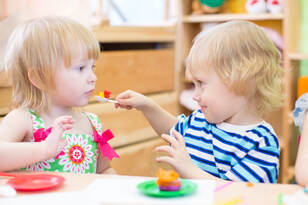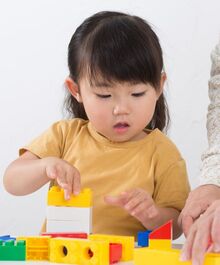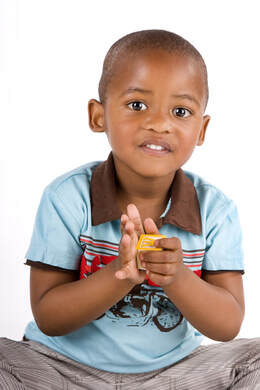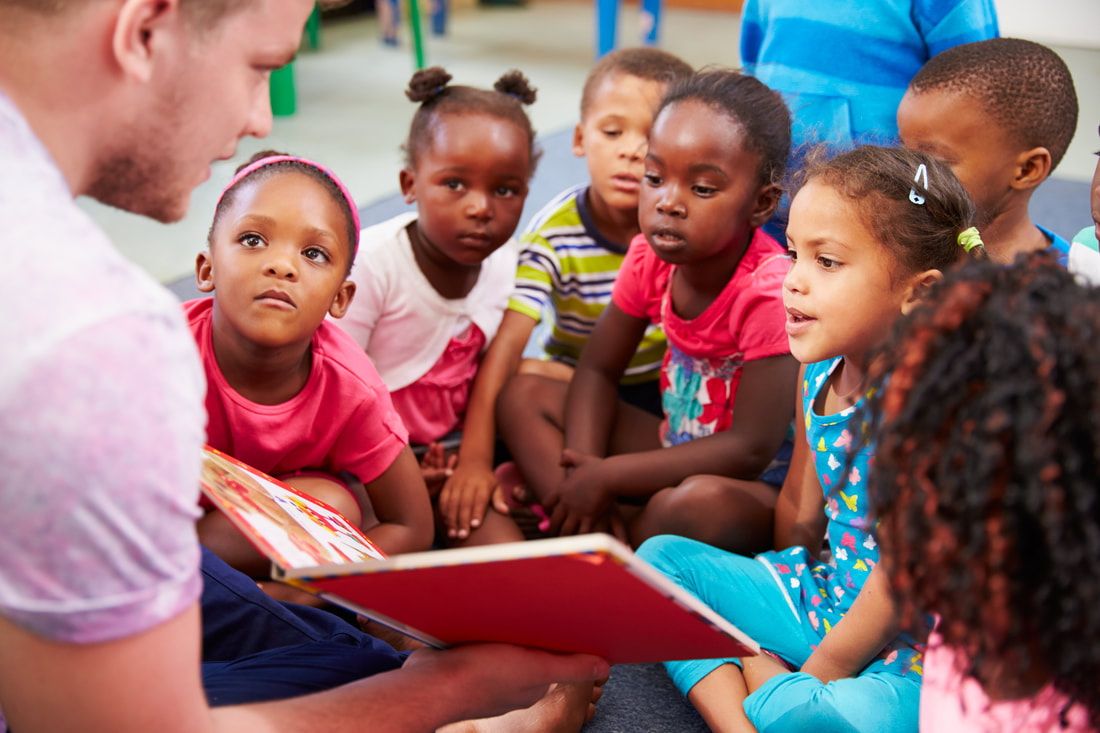|
During the preschool years, children's language is developing most rapidly, especially from birth to age three. Children are learning to understand language (receptive language) and to use language to communicate (expressive language). Children's language abilities affect their learning and development in all areas, and they begin at birth, as babies use cries and body language to communicate. Of course, infants and young children develop language with our help; we'll explore ways to support them from birth to age five. Theories of Language DevelopmentDo you wonder how young children learn such a complex skill as communicating with language? Three scientists have offered theories to explain how to understand how children learn to understand language and to speak so amazingly quickly and easily. Each of these theories contributes toward our current understanding of language development.
Language Development Milestones and How to Support ThemLanguage develops best when children have interactive and responsive relationships with caring adults. Caregivers who are familiar with the developmental stages and are attentive to each child’s individual needs can respond quickly and consistently to meet those needs. This cycle of responsiveness is crucial, assuring children that they are safe and cared for and allowing them to freely explore the environment. Each child develops at his or her own pace, but generally children reach language milestones in the same order during the same range of time. Let's look at these accomplishments and what we can do to foster them. Birth to 8 Months  Infants begin communicating with their caregiver at birth. They are comforted by familiar and soothing sounds and intently focus on faces. They communicate their needs by crying and their contentment with cooing. In just a few weeks after birth, they begin to smile when spoken to and maintain eye contact. They communicate through body language, holding out their arms to be picked up; reaching, clapping, and turning in response to familiar words and phrases. They also begin to use joint attention to communicate and as a tool for learning the names of objects. Joint attention is when an infant follows the gaze of a caregiver to an object.
Supporting Language at this Stage: -Talk soothingly to very young infants. They respond positively to a soft, high-pitched, melodic voice. This is sometimes referred to as motherese; it isn’t baby-talk. Even young infants initiate communication frequently, so be on the lookout for children's efforts and respond to their attempts. -Play connecting games to build relationships (See the blog post for examples). -Use serve and return interactions, responding to the looks, sounds, and gestures you see, then pausing for the infant to take a turn. Responding to non-verbal communication tells infants that they are heard and encourages them to communicate more often. -Infants need to hear lots of language, so talk with them a lot. You can narrate what you are doing (self-talk) and what children are doing (parallel talk). For example, “I can see that your diaper is wet. I am getting a new one so I can change you" (self-talk). “You are putting the blocks in the bucket!” (parallel talk). You will be expanding children's vocabulary and giving them the interaction they are eager for. -Books are for babies, too! Reading to them every day is good for Infants of all ages. They learn the flow of language as they tune into pictures of familiar objects. Having access to books helps them enjoy the closeness and interaction as they are read to. They can also practice shared attention as you discuss stories, and they can initiate reading by bringing you a book. 8 to 18 Months  During this time, infants can understand much of what they hear. They can follow simple instructions like, “go get your ball”. They recognize the names of familiar objects and respond to their own name. They turn their attention to someone that is speaking and make eye contact. This is also an exciting time of first words! Infants begin to use one word phrases accompanied by hand gestures and non-verbal cues to communicate. These holophrases can convey an entire sentence. For example “Cup?” might mean "May I have my cup?" By 18 months, infants may have 30 - 50 word vocabularies, but this varies greatly based on the individual child.
Caregiver Responses: Continue to use the strategies recommended for younger infants, and add new songs, word games, and rhymes. Model listening and responding, and play interactive sound and word games that mimic the turns of a conversations – such as beating a drum or call and response songs where children repeat after you. From 18 Months to 3 Years  Toddlers listen, respond and gain new words every day; their vocabularies grow rapidly during this stage. Toddlers can follow two-step instructions, and begin to appreciate and respond to funny comments and rhymes. They start to talk with peers, listening and responding to one another. Toddlers' speech moves quickly from two-word and three-word sentences to more complex sentence structure by age three.
Caregiver Responses -As toddlers become more verbal, you can use new techniques to scaffold their language development: Recasting and expansion. Recasting means restating the child’s sentence using correct grammar. You don't need to point out the mistake or correct the child, simply reword what they say. For example, if a child says “Spot digged a hole,” Say, “Yes, Spot dug a hole.” Expansion means adding to the child’s statement; “Yes, Spot dug a big hole. He wanted to bury his bone.” Your job is to model mature language and increase vocabulary. -You can also use language to describe emotions and help toddlers begin to identify their feelings. Before reminding toddlers to "use your words", tell them the words to use when they are upset or in a conflict with a peer. Young children need lots of modeling, support and practice to use language to help them regulate their emotions. Help them find the words to identify their feelings. “It looks like you are really angry that it's time to stop playing. Let's find something that will help you feel better.” -Ask open-ended questions. This also extends learning and invites the child to express himself or herself. -Provide toddlers with a variety of new materials and experiences. This expands vocabulary and keeps toddlers engaged in their environment. Explore the outdoors, following the children’s lead and talk about the things they find interesting. -Continue to provide access to books and lots of opportunities for reading every day. Read to toddlers in small groups and one-on-one, and let toddlers to explore books independently as well. From 3 to 4 Years  Three-year-olds are able to more effectively use language to communicate. They've learned the rules of conversation and begin to talk more with peers and caregivers. They can answer questions, so ask them starting with who, what, when, where and why. You may even pose more complex questions, such as how and if/then. Threes can usually follow three-step instructions. Three-year-olds are learning multiple words to describe and talk about their feelings. They are beginning to resolve conflicts with peers and provide comfort with language. They begin to use phrases such as “I think” and “I have an idea” and “I guess” that indicate their thought process. Threes can more consistently apply grammar rules regarding past tense and possessives, and can more accurately use pronouns like he, her, they and we.
Caregiver Responses: Direct interactions between caregivers and children are still important, but three-year-olds interact with one another more frequently. Your role is to create an environment that is supportive of these peer interactions: A classroom with well-defined and engaging learning centers, spaces for small group and one-on-one activities, and interesting materials that foster problem-solving and require cooperation (i.e. simple board games, dramatic play, and construction materials). Provide consistent and clear expectations that allow children to explore with confidence. Include both small and large group activities (reading, storytelling, singing, and word games) that extend threes' vocabulary and model effective social communication. From 4 to 5 Years  Four-year-olds have a greater understanding of of grammar rules: Over-regulation (for example, adding -ed for all words to indicate past tense) gradually disappears by about age 5. Four-year-olds may have trouble with certain types of words: opposites, negatives, connectives (if, or, but) and question words (how, why, when). From four to five years, children's vocabulary grows from about 4,000 words to about 8,000- 12,000 words. Four-year-olds converse more with other children, adapting their speech to the needs of the listener.
Besides continuing to develop receptive and expressive language, preschoolers are also developing literacy - the knowledge and skills related to reading and writing. For ideas about what is involved and how you can support emergent literacy from birth to age five, watch for our next blog post in May. Until then, enjoy helping your young children's language skills develop! ReferencesTexas Early Learning Council. (2013). The Texas Infant, Toddler, and Three-Year-Old Early Learning Guidelines. https://littletexans.org/Media/FullGuidelinesEnglish.pdf
Kostelnik, M. J., Rupiper, M., Soderman, A. K., & Whiren, A. P. (2014). Developmentally Appropriate Curriculum in Action. Upper Saddle River, NJ: Pearson Education, Inc.
1 Comment
|
AuthorI'm Diane Goyette, a Child Development Specialist, Trainer, Consultant and Keynote Speaker. I'm excited to share my blog! Archives
August 2023
Categories
All
|
|
Ways to Contact Us:
Schedule an Appointment |
|
Follow earlychildhoodspecialties for encouragement, teaching tips and more!
|
Follow eepworm for child-friendly posts!
|
© 2013-2024 Early Childhood Specialties LLC. All rights reserved.


 RSS Feed
RSS Feed